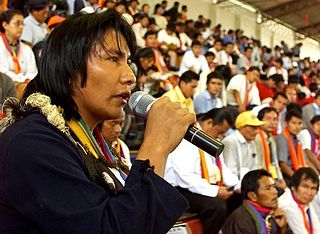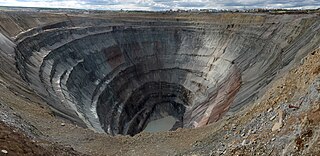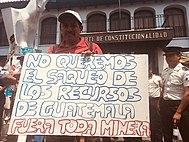
The Confederation of Indigenous Nationalities of Ecuador or, more commonly, CONAIE, is Ecuador's largest indigenous rights organization. The Ecuadorian Indian movement under the leadership of CONAIE is often cited as the best-organized and most influential Indigenous movement in Latin America.
Environmental justice is a social movement to address environmental injustice, which is the exposure of poor and marginalized communities to harm from hazardous waste, resource extraction, and other land uses from which they do not receive benefits. The movement has generated hundreds of studies showing that exposure to environmental harm is inequitably distributed. One example of this is environmental racism. Environmental justice is the fair treatment and meaningful involvement of all people regardless of race, color, national origin, or income, with respect to the development, implementation, and enforcement of environmental laws, regulations, and policies. Fundamentally, the goal is to provide agency in environmental decisions to people of all demographics.
Goldcorp Inc. was a gold production company headquartered in Vancouver, British Columbia, Canada. The company stood among the largest gold producers in the world, employed about 15,800 people worldwide, engaged in gold mining and related activities including exploration, extraction, processing and reclamation. Goldcorp’s operating assets included eleven mines in North and South America.
San Rafael Las Flores is a municipality in the Santa Rosa Department of Guatemala. As of 2020 has a population of 13,620.
Indigenous land rights are the rights of Indigenous peoples to land and natural resources therein, either individually or collectively, mostly in colonised countries. Land and resource-related rights are of fundamental importance to Indigenous peoples for a range of reasons, including: the religious significance of the land, self-determination, identity, and economic factors. Land is a major economic asset, and in some Indigenous societies, using natural resources of land and sea form the basis of their household economy, so the demand for ownership derives from the need to ensure their access to these resources. Land can also be an important instrument of inheritance or a symbol of social status. In many Indigenous societies, such as among the many Aboriginal Australian peoples, the land is an essential part of their spirituality and belief systems.
The Xinka, or Xinca, are a non-Mayan indigenous people of Mesoamerica, with communities in the southern portion of Guatemala, near its border with El Salvador, and in the mountainous region to the north.
Pan American Silver Corporation is a mining company based in Canada with operations in Latin America. The company has mines and other projects in Mexico, Peru, Bolivia, and Argentina.
Indigenous people under the nation-state have experienced exclusion and dispossession. With the rise in globalization, material advantages for indigenous populations have diminished. At times, national governments have negotiated natural resources without taking into account whether or not these resources exist on indigenous lands. In this sense for many indigenous populations, the effects of globalization mirror the effects of the conquest in the mid 16th century.
Mining in Ecuador was slow to develop in comparison to other Latin American countries, in spite of large mineral reserves. As late as 2012, according to the United Nations, Ecuador received less foreign direct investment per person than any other country in Latin America. During the 1980s, mining contributed only 0.7 percent to the Ecuadorian economy and employed around 7,000 people. Minerals were located in regions with little to no access, hindering exploration. Ecuador has reserves of gold, silver, copper, zinc, uranium, lead, sulfur, kaolin and limestone. The latter practically dominated the early industry as it was used in local cement plants.

Corriente Resources was a multinational corporation based in Canada that completed feasibility studies and environmental impact assessments (EIA) for open-pit copper mines in the Ecuadorian rainforest, including the Mirador mine. The Mirador mine is the first industrial scale copper mine to be developed in Ecuador. Corriente Resources also completed explorations of the San Carlos Panantza mine, although development of that project was halted in 2020 by Indigenous opposition.
The Marlin Mine is a gold mine in Guatemala owned by Montana Exploradora de Guatemala, S.A (Montana), which is a subsidiary of Canadian company Goldcorp.

Tahoe Resources Inc. was a mining company and intermediate precious metals producer with silver and gold mines in Canada, Guatemala and Peru. It was founded in Vancouver, British Columbia by Kevin McArthur, former CEO of Glamis Gold and Goldcorp. Incorporated in British Columbia, Canada, the company's U.S. headquarters is located in Reno, Nevada.
Canadian mining in Latin America and the Caribbean began in the 20th century. Latin America and the Caribbean's vast resources give the region great geopolitical importance, attracting foreign interest for centuries. From the colonial race of European empires, to the multinationals of today's neoliberal capitalist world, this region continues to draw interest. Canada's involvement in Latin America increased dramatically since 1989 with several landmark negotiations and agreements. By 2009, the Canadian larger-company mineral exploration market in this region was valued at US$1.7 billion.
The 2012 Ecuadorian protests were a series of demonstrations by indigenous peoples who oppose the copper mining concessions in the province of Zamora-Chinchipe. On 22 March, the protesters reached the capital Quito to be met with counter protesters and warnings from the government and President Rafael Correa.
The Escobal mine is a large silver mine located east of San Rafael Las Flores in the south of Guatemala in Santa Rosa Department. Escobal represents one of the largest silver reserve in Guatemala and in the world having estimated reserves of 367.5 million oz of silver. Exploration was by Goldcorp beginning in 2007. The mine was sold to Tahoe Resources in 2011. In April 2013 the mine was granted a 25 year license. The local Xinca people have led protests opposing the Escobal mine, but these protests have been suppressed by the Guatemalan government.
The Fenix nickel project also known as El Estor mine is an integrated mountain-top nickel mine and processing facility near El Estor in the Izabal Department of eastern Guatemala. The project consists of a cluster of several deposits with reserves amounting to 36.1 million tonnes of ore grading 1.86% nickel. The project is owned by Solway Group through Guatemalan subsidiaries CGN and Pronico.
The Mirador mine is a large copper mine located in the Amazonian province of Zamora-Chinchipe in southern Ecuador. It is one of the largest copper reserves in Ecuador, and the first industrial-scale copper project to be developed in the country. The project has generated an environmental conflict that is emblematic in the national political debate on mining.
The mineral industry of Guatemala includes:

Extractivism is the removal of natural resources particularly for export with minimal processing. This economic model is common throughout the Global South and the Arctic region. The concept was coined in Portuguese as "extractivismo" in 1996 to describe the for-profit exploitation of forest resources in Brazil.

The Lega Dembi Mine is the largest gold mine in Ethiopia and is near Shakiso in Oromia. Lega Dembi has a yearly production of around 4,500 kg of gold and silver, and is owned by MIDROC. Pollution from the mine has resulted in environmental conflict that has exacerbated other political and ethnic conflict in the region.









